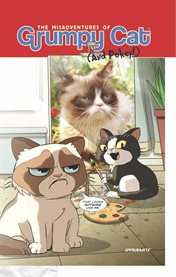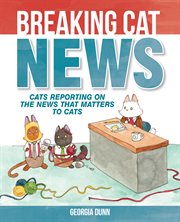Review by Booklist Review
Best known in America for his Little Vampire children's books, French comics creator Sfar here presents a story seemingly based--the surname Sfar crops up--in familial history. A rabbi, a widower nearing 60, lives with his nubile daughter, a cat, and a parrot in 1930s Algiers. The cat narrates throughout, but the parrot doesn't last long. Annoyed by its squawking, the cat eats it, after which the cat can speak human language (it immediately lies about the parrot, so the rabbi forbids it to talk to his daughter--and, oh, by the way, it could already read), at least until it calls out the name of God, after which it's back to "meow." Subsequent big events include a visit by the rabbi's handsome, charismatic cousin (is it charisma, though, or the lion that always accompanies him that makes others fawn on him?), the rabbi's French-dictation test by the rabbinical college in Paris, the arrival of a new young rabbi, the daughter's marriage, and the rabbi's journey with the newlyweds to Paris to meet the groom's very secular parents. It is, altogether, utterly charming. Sfar's artwork, crammed with detail (sometimes ravishing, as when the rabbi, in the background, is also seen through a raindrop in the foreground), recalls that of Ludwig Bemelmans' Madeleine books, and his portrayal of a society in which Jews and Muslims were friends and comrades speaks volumes to our times. --Ray Olson Copyright 2005 Booklist
From Booklist, Copyright (c) American Library Association. Used with permission.
Review by Publisher's Weekly Review
Sfar, the French cartoonist behind the Little Vampire children's books, has come up with a hilarious and wildly original graphic novel for adults. The nameless, scraggly-looking alley cat who narrates the story belongs to an Algerian rabbi in the '30s. When the cat eats a parrot, he gains the power of speech and tries to convince his master to teach him the Torah, raising the question of whether the appropriate age for his bar mitzvah should be in human years or cat years. Of course, being a cat, he has plenty of impertinent opinions about Judaism. That's a delicious setup on its own, but it gets better when the cat loses his speech again halfway through, and the story becomes a broader, more bittersweet comedy about the rabbi's family and the intersection of Jewish, Arab and French culture. The rabbi's daughter Zlabya marries a young man from a nonobservant family in France. The Algerian family's visit with their Parisian in-laws is the subject of the final and funniest section of the book. Sfar's artwork looks as mangy and unkempt as the cat, with contorted figures and scribbly lines everywhere, but there's a poetic magic to it that perfectly captures this cat's-eye view of human culture and faith. (Aug.) (c) Copyright PWxyz, LLC. All rights reserved
(c) Copyright PWxyz, LLC. All rights reserved
Review by Library Journal Review
In this agreeable ramble of a tale, set in 1930s Algeria, a cat belonging to Zlabya, the daughter of a rabbi, eats a parrot and gains the power of speech. The cat, as might be expected of a cat, proves to be a grand skeptic with a smart mouth and engages in lacerating theological discussions with the rabbi and with the rabbi's master. In the second half, the focus moves away from the cat and features a visit by the rabbi's imposing cousin Malka and his pet lion; a threat to the rabbi's position; a suitor for Zlabya; and a trip to Paris. Sfar, cocreator of NBM's series Dungeon, won a prestigious French award for this book, and its likable characters and good humor are winning. Sfar's unruly full-color artwork, likewise endearing, alternates the cartoony, changeable style with occasional glimpses of more realistic rendering. His portrayal of a spectrum of Jews as they deal in their own ways with the rules and customs of their faith is thoughtful, witty, and deeply human. With nudity and mature themes, this is recommended for adult collections, for which it's strongly recommended. [See Prepub Alert, LJ 4/15/05.] (c) Copyright 2010. Library Journals LLC, a wholly owned subsidiary of Media Source, Inc. No redistribution permitted. All rights reserved.
(c) Copyright Library Journals LLC, a wholly owned subsidiary of Media Source, Inc. No redistribution permitted.
Review by School Library Journal Review
Gr 9 Up-A slinky gray cat lives with a rabbi and his beautiful young daughter. One day, the feline eats their parrot, only to find that he has gained the birds ability to talk. Witty and highly intelligent, the cat immediately decides that he wants to learn more about Judaism, from the Kabbalah to the Torah. Thus begins this funny, sad, spiritual, and utterly delightful trio of tales. The stories tell much about Jewish life in the 1930s, both in the initial setting of Algeria and in Paris. They also impart Jewish teachings and philosophies in a highly entertaining way, bringing to mind Jostein Gaarders Sophies World: A Novel about the History of Philosophy (Berkley, 1996). Sfar is predominantly known in this country for his Little Vampire childrens series (S & S), and the drawings have the colorful, cartoon quality of those works while still fitting the sophistication of these. His palette is a gorgeous mix of earth tones that perfectly captures the North African setting. There is plenty for teens to like-humor, romance, and theological questioning combined with a folkloric quality to bring to life a multifaceted work. Sfar is highly praised in France; heres hoping more of his creations are translated.-Jamie Watson, Harford County Public Library, MD (c) Copyright 2010. Library Journals LLC, a wholly owned subsidiary of Media Source, Inc. No redistribution permitted. All rights reserved.
(c) Copyright Library Journals LLC, a wholly owned subsidiary of Media Source, Inc. No redistribution permitted.
Review by Kirkus Book Review
An Algerian rabbi's cat gains the power of speech, giving it all the greater ability for mischief. This first major English-language graphic novel by French comic whirlwind Sfar (Dungeon, 2004, etc.) is an initially whimsical but ultimately bracing fable. Set in 1930s French colonial Algeria, the story concerns a rabbi's cat that learns to speak after eating its master's talking parrot. The rabbi--a rotund and somewhat underappreciated fellow who's in danger of being supplanted by a younger and more book-smart rabbi from France--is devastated by this development, especially when he finds the cat has a sarcastic tongue and likes to get into tangled theological debates. The story meanders about in an easygoing manner, following the rabbi's daughter's love life, a journey to Paris and the cat's various musings on life--when, that is, he's not causing trouble ("I tell the rabbi's rabbi that I am God, who has taken the appearance of a cat in order to test him"). Although dusted with fantasy, the book is powerfully real, etched with the dark shadows of an ancient society where Jews, French and Arabs mixed, a world soon to be swept away by the winds of war and modernity. Sfar's artwork is playfully exaggerated, adding to the otherworldly feel here, while his writing is smart and sharp, perfectly counteracting any burgeoning colonial-era nostalgia the pages might evoke. An unexpectedly haunting work from a major talent. Copyright ©Kirkus Reviews, used with permission.
Copyright (c) Kirkus Reviews, used with permission.


